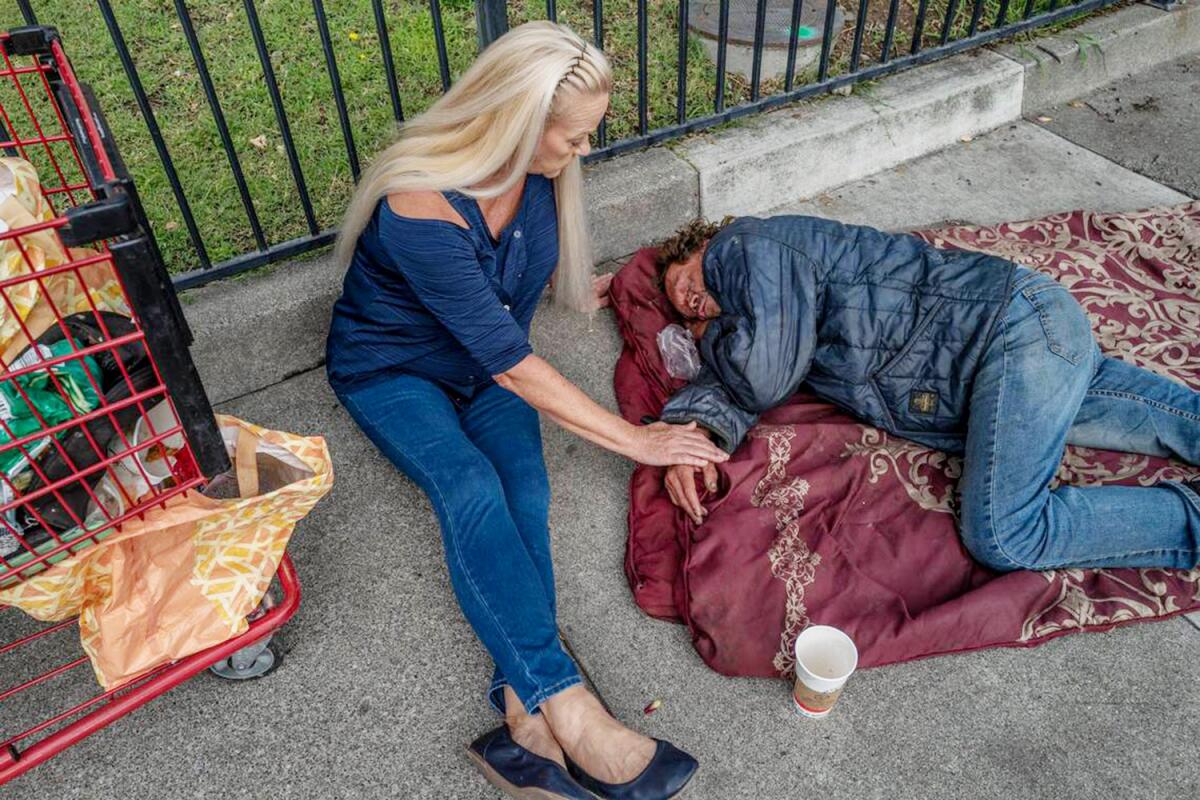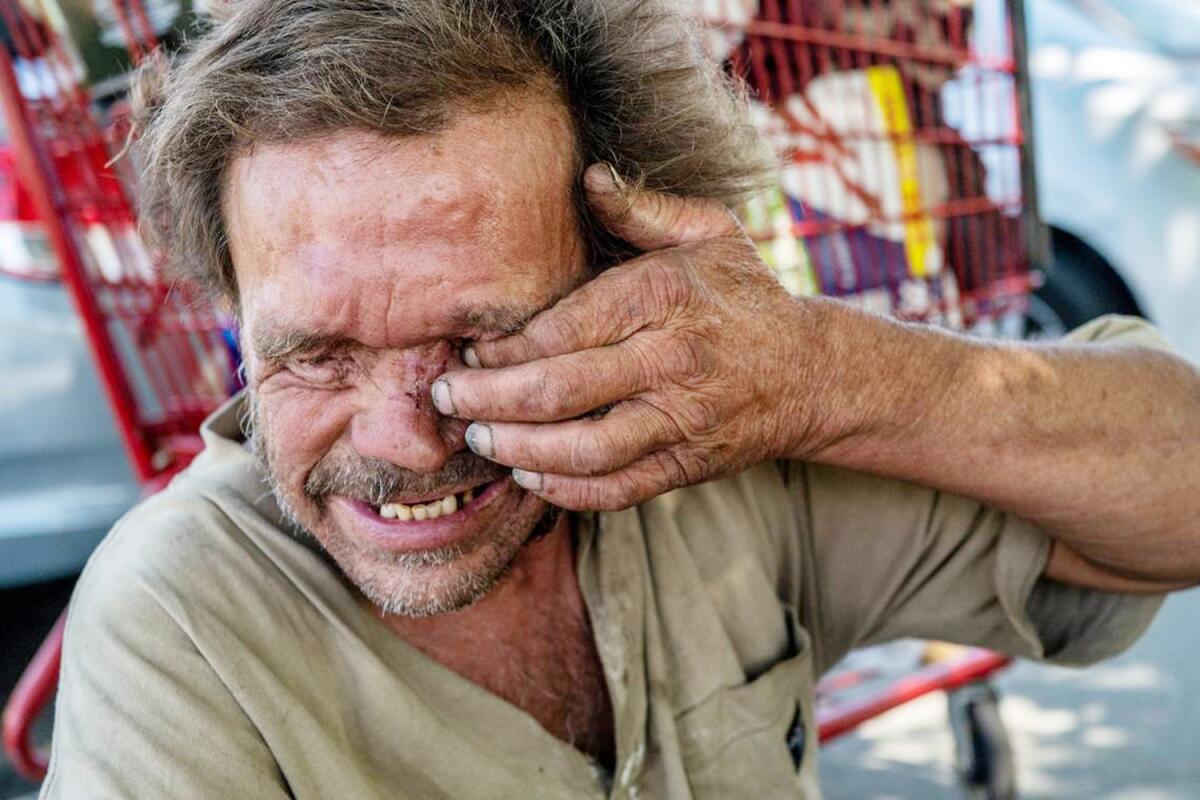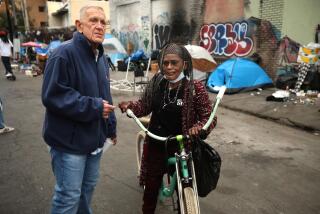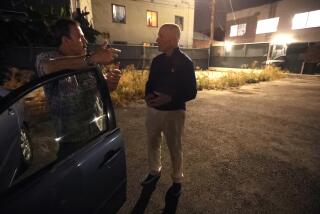Column: California’s most famous homeless man is dead. His life should guide CARE Court

VACAVILLE, Calif. — For the 16 years James Mark Rippee lived on the streets of this Bay Area town, his sisters Catherine Rippee-Hanson and Linda Privatte unsuccessfully begged politicians, bureaucrats and medical professionals to give their schizophrenic baby brother the help he so clearly needed — but didn’t want.
Their advocacy made Rippee possibly the most famous homeless man in California — known well to state and local legislators and repeatedly written about by media. But it did no good.
In late November, Rippee was dumped at a hospital in the middle of the night gasping for breath, still too deep in his severe mental illness to understand he needed medical care. He died a few days later at the age of 59.
Officially, he was killed by pneumonia and sepsis that led to organ failure, but Rippee-Hanson is clear that the real cause is the ugly fight between civil libertarians and families like hers over when it is fair and necessary to intervene in the life of someone with serious mental illness.
“When did families lose the right to protect their own loved ones?” she asked me recently, less of a question than a statement of frustration and sorrow. “All we were trying to do was keep him alive.”
That brawl over what moral and legal justice looks like for our most severely mentally ill is headed — once again — into California’s court system, where many efforts to reform our laws have been quashed in recent decades.
Last week, as my colleague Hannah Wiley wrote, a trio of disability rights and civil liberties groups filed a lawsuit with the state Supreme Court to stop Community Assistance, Recovery and Empowerment Courts (CARE Courts), Gov. Gavin Newsom’s plan to address the logjam of aid for those with serious brain disease.
If the Supreme Court accepts the case, or even sends it back to be litigated in lower courts, it could put on hold indefinitely California’s only real plan for helping our most vulnerable and seriously mentally ill. More people like Rippee will die on our streets. More families like his will be left shamed and blamed for trying to help.
Because in California, if someone like Rippee doesn’t want mental health care, even if they are in deep psychosis, it is nearly impossible for family members to do anything.
It is considered a violation of civil rights.
“It feels like David and Goliath. It feels like it’s the family members trying to open the eyes of people who think they have some higher, righteous goal to protect the rights of someone who can’t choose,” Rippee-Hanson said. “If Mark wasn’t gravely disabled then no one in California is.”
CARE Court has largely been billed as a plan to address homelessness, and that’s probably the governor’s biggest misstep in what is otherwise a good and necessary idea. That framing has led to justifiable fears that the new courts will be used to unfairly pick up, and maybe even lock up, homeless people deemed troublesome or disruptive, people with substance use disorders or less serious mental illness.
In their filing, the three organizations petitioning to stop CARE Court, Disability Rights California, Western Center on Law and Poverty, and the Public Interest Law Project, argue that “thousands of unhoused Californians with mental illness will be threatened with court orders, forced into involuntary treatment and swept off the streets, not because they are a danger to themselves or others, but because a judge has speculated they are ‘likely’ to become so in the future.”
If that were how CARE Court turned out, it would be unconscionable. We are all heartsick with the endless suffering on our streets, angry and frustrated with a problem that seems to be growing exponentially worse despite countless political promises to fix it. Still, few among us want to see people institutionalized, or deprived of their right to autonomy.
But as Rippee-Hanson puts it, “What about the right to live? What about the right to get treatment for a disease that is no fault of your own?”
It did not matter to civil libertarians or the powers that be that Rippee heard voices and had delusions that left him trapped in his own reality. For a time, he believed that the police were growing new recruits inside of him — spawning other humans with his body as an incubator — and it was the whispers of those creatures that rattled in his head.
It did not matter that he had lost both his eyes and part of his frontal lobe in a motorcycle accident that sent him hurtling into a grain harvester when he was 24.
It also didn’t matter that he was hit by cars twice, or that he often slept in front of the county building, forcing those charged with helping him to walk by him on a regular basis and watch him suffer outside of their office windows.
Mark Rippee was trapped by a cruel disease that made decisions for him. And his sisters, who spent nearly every day of their adult lives caring for him as best they could, lost decades trying to explain the pain and horror of that alternate reality for all of them as he deteriorated into a “mangled, broken man,” as Privatte, Rippee-Hanson’s twin, described him.
They should have had some sort of right, limited by great oversight, to help this beloved sibling. And that is what CARE Court will do.
Although the law allows medical providers, police and others to file a CARE Court petition, it more importantly allows family members to do so. One of the most crucial aspects of CARE Court that is getting lost in translation is that people like Rippee-Hanson and Privatte could finally have a powerful tool to stabilize their ill loved ones, before they become homeless or crumble into sickness and death.
CARE Court could compel counties to provide services and treatment to people such as Rippee, finally. This is the part of CARE Court that few talk about — the requirement that counties and other service providers comply or be sanctioned.
Right now, people with serious mental illnesses like schizophrenia are often last in line when it comes to getting help, because they can be hard to deal with and time-consuming. It’s much easier to shrug our shoulders and say someone like Rippee refused help, and instead use our scant resources on those with lesser needs. This has been Rippee-Hanson’s experience so many times that even she is skeptical of CARE Court, fearful its potential will turn out to be just another false promise.
There’s individual accountability in it, though, and oversight that gives me hope.
Under CARE Court, a judge has the power to order stable housing, to ensure that the person isn’t falling through the cracks of services, to force government to do more in the toughest cases. In effect, it takes an estimated 12,000 people who are nearly always shut out of services for one excuse or another and puts them front and center.
But CARE Court is not involuntary treatment. Though those referred to it do receive notices to appear in court, there is no penalty for ignoring anything the court orders. There is no punishment for not taking part in any treatment plan. A person can just not show up and little would happen besides visits from social workers — no bench warrant, no cops looking for them, no needle injecting medications against their will.
CARE Court is a one-year program that can be extended to two years. If the person doesn’t participate, the only possible consequence is that they can be referred for a conservatorship, an entirely separate legal proceeding that may or may not end up with the person being placed under the supervision of the state.
It’s true that there’s a “black robe effect,” as the lawsuit claims, that appearing before a judge can make it feel like compliance is required. Maybe that nudge of authority isn’t all bad, for those who need help and for those who are supposed to provide it.
I went to Rippee’s memorial service at the Moose Lodge in Vacaville a few weeks ago, where he played pool in better days. Privatte, raw with grief, spoke on a beige stage, mounted antlers decorating the wall above her. She described a little brother who loved to play pranks. Rippee was the kind of kid who, after meeting her fourth-grade teacher Mr. Slacks, called every pair of pants he owned “Mr. Slacks” for years to come.
“I can still feel his tiny hand in mine,” she said. “A vivid memory of a simpler time when we walked to the grocery store and home.”

State Sen. Susan Talamantes Eggman (D-Stockton), a longtime champion of families like the Rippees, also paid her respects. Eggman’s aunt had bipolar disorder, so she understands the complexities.
“The people with untreated mental health issues aren’t the only ones that suffer,” Eggman said. “It’s the families who feel so helpless, who, over and over and over again, have asked for help. And with whatever compassion we think we have, we have turned a blind eye and said ‘No, people have rights.’”
CARE Court will be running in seven counties by fall if the lawsuit is not successful in stopping them. Los Angeles will join a few months later, by far the largest and most significant county to participate.
It is a program that bears scrutiny and requires transparency. We should all keep watch to make sure it isn’t abused or misused, because it is the most serious of state interventions to curtail someone’s liberty.
But James Mark Rippee died with his rights intact, and the failure of our all-or-nothing mentality on full display.
It wasn’t civil, and it wasn’t right.
More to Read
Sign up for Essential California
The most important California stories and recommendations in your inbox every morning.
You may occasionally receive promotional content from the Los Angeles Times.











